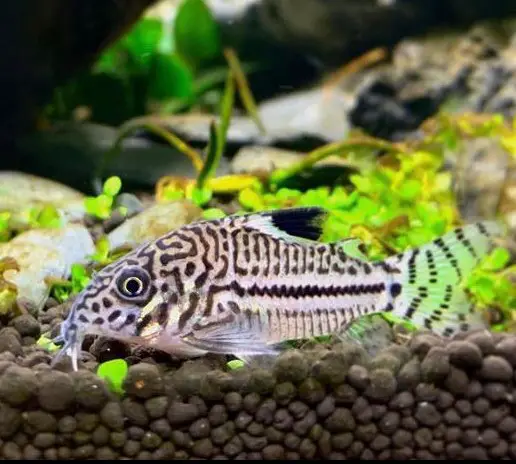Cory Catfish, also called Cory Cats, are a popular choice for freshwater pet fish. They are usually kept as pets for aquariums and are considered to be hardy fish for their size.
Cory Cats are usually seen as ‘armored’ catfish, because of the plates of material that runs down the length of their bodies, which is similar to bones.
There are different types of Cory cats, and all of these vary in terms of color and size, but the most common types are the Bronze Cory Catfish.
They are kept as pets by many fish enthusiasts, particularly because they are so easy to take care of and have such little requirements.

What to Look For When Buying a Cory Catfish
When you go out to buy a Cory Cat, you should look for a fish that looks healthy and alert and moves frequently. You would want to see that there has been no damage to its fins and tail and that it has both its eyes.
Cory Catfish also have barbels on the sides of its mouth, which look like whiskers, so you would want to see that these are complete.

In some cases, the display tanks that Cory Cats are kept in may have other fish that would nip at them and cause damage to the sensitive area around their mouth, so you would want to make sure that your fish is not injured, nor that it comes from tanks where fish are diseased, sick or dead. These may be indications that your Cory Catfish would be unhealthy, and if you are going to keep your fish in a tank with others, they may be at risk as well.
Caring for Cory Catfish
It’s very easy to take care of a Cory Catfish. Corys are very calm and peaceful and do not have an aggressive temperament. Some of them are also more shy and timid than others, and this may because of their size when compared to other fish in their tank. Some people believe that it may be the tank dynamic, since Cory Cats are active and curious fish that stay near the bottom of the tank, usually scavenging for food to eat.
They are also very active in the daytime, but can also be found resting in one spot, motionless. Corys are also active during the night, making rounds around the tank, but most often, they will be much more active during the day.
Keeping Cory Catfish
Cory Catfish can live in tanks of almost any size and dimension. They can thrive in small tanks as well as big tanks, but it is important to remember that more species will tax the capacity of the tank, so you should keep the fish count in mind. It is also important to keep the tank covered from all sides because Cory Catfish will often swim up to the surface to get a piece of food that may be floating on the surface or to get a gulp of air. This causes a snap and pop sound, and while many new hobbyists worry about there being a lack of oxygen, this is normal behavior for Corys.
Cory Catfish are also very social, and while they can survive on their own, they are happier when there are other fish around them. Generally, Corys of all types tend to stick together, so it is not uncommon to see them move around together or even to stay near the other while it rests.
Corys do not manage to live in tanks with poor water conditions, and high levels of nitrates can make them susceptible to disease. They must also remain in stable water pH and temperatures.
Cory Catfish Diet
Cory Catfish’s diet includes basic fish foods, including flakes, pellets, and tablets. Corys usually spend hours roaming around the tank bottom looking for food and can even move the surface gravel while digging around. Because of this, it is best to keep them in a tank with a couple of inches of gravel, or live plants. This is also why foods that sink are much better since they replicate their natural feeding habits.

Corys are omnivorous and eat small insects, worms, and larvae. They will also eat plants and any vegetable matter that falls into the tank. Cory Catfish are not known to eat snails and shrimps if they are within the same tank (though they do eat shrimp pellets), but in some cases, if the snail is crushed, then Corys get excited and feast on the crushed snail.
Cory Catfish also eat algae wafers, bloodworms, and daphnia as treats.
Corys can also eat small eggs of other species they share the aquarium with, and spend most of their time looking for food. However, Corys are to be fed once a day, and you should change their food source every few days to make sure they are receiving all the nutrients they need to remain healthy.
Lifespan
Because they are ‘armored,’ the lifespan of a Cory Catfish is longer than that of other fish. Cory Catfish can live up to 5 years or much more, depending on the conditions and whether they are cared for adequately. However, while this is true, it is also possible for Corys to die soon after being transferred to a tank. This is usually because of the stress of being transported or the shift in water conditions from what they are used to. However, some kinds of Corys are not as susceptible to this as others.

